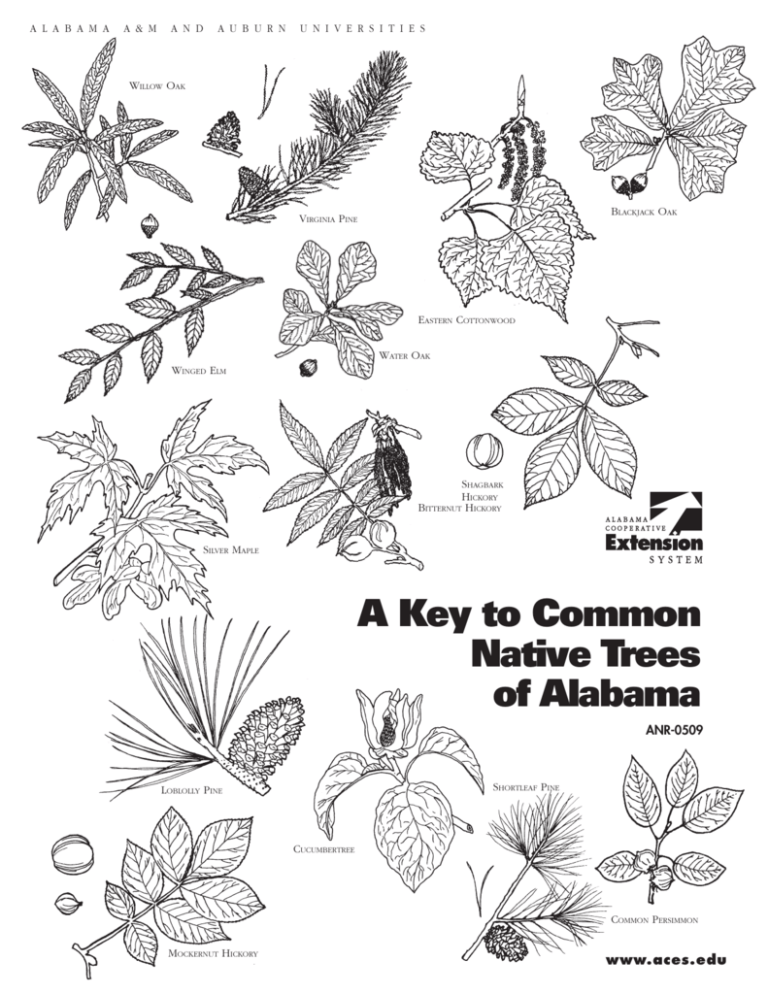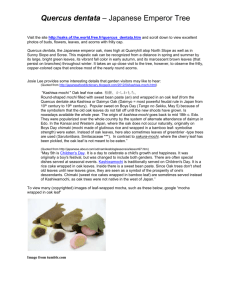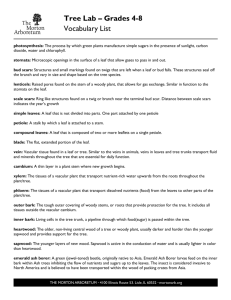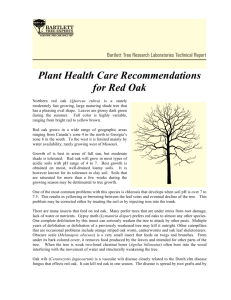
A L A B A M A
A & M
A N D
A U B U R N
U N I V E R S I T I E S
Willow Oak
Blackjack Oak
Virginia Pine
Eastern Cottonwood
Water Oak
Winged Elm
Shagbark
Hickory
Bitternut Hickory
Silver Maple
A Key to Common
Native Trees
of Alabama
ANR-0509
Shortleaf Pine
Loblolly Pine
Cucumbertree
Common Persimmon
Mockernut Hickory
www.aces.edu
Black Walnut
Eastern Redbud
Chestnut
oak
Eastern
Redcedar
American Beech
Southern Red Oak
Shumard
oak
Longleaf Pine
American
Holly
American Elm
Overcup Oak
Yellow-Poplar
or
Tuliptree
Red Maple
2
Slash Pine
White Oak
Red Mulberry
Sycamore
A Key to Common
Native Trees of Alabama
This key can help you identify 69 of the most common native trees found
in Alabama. Keys such as this one, which is based on a series of choices between two statements, are called dichotomous keys. This key was designed for
use during the growing season; therefore, leaf characteristics are the primary
River Birch
Sweet Bay
features used for identification.
A listing of the common and scientific names for the 69 trees is found
on page 9. This key will not work for trees that do not appear on this list. The
following suggestions should help you as you begin working with the key:
(1) Always start at the beginning of the key and follow it step by step. Each
choice will refer you to the next step, which may be a number, another section
in the key, or the conclusion or species. It is a good practice to write down
your order of progress, such as 1 - 2 - 4. This will make it easier for you to
find and correct mistakes.
(2) Always read both choices, even if the first choice sounds correct. The
second one may sound even better.
(3) If the choice between two statements is not clear, or you don’t
have enough information to make the choice, follow both choices to their conclusions. Then, try to choose between the descriptions of the two
resulting answers.
(4) Always look at several samples when keying a specimen. Key characteristics, especially leaves, can vary even on the same tree.
(5) When measurements are given, as in the size of the leaves, don’t guess.
Use a ruler.
(6) Become familiar with the botanical terms used to describe trees. Terms
used in this key are illustrated on pages 10 through 13.
Some of the species covered do not occur throughout the state. The following codes indicate the general range where each occurs. S—southern third
of state, C—central portion of state, N—northern third of state, A—all of state.
A Key to Common Native Trees of Alabama 3
Tree Identification Key
1. Leaves needle-like or scale-like; trees with cones ………………………………………………… see Conifers
1. Leaves flat and broad; trees without cones ……………………………………………………… see Hardwoods
Conifers
1. Leaves needle-like ……………………………………………………………………………………………………… 2
1. Leaves scale-like, sometimes longer (¼ inch) pointed on the end and prickly to the touch;
bark reddish-brown and fibrous; cones look like bluish-gray berries about ¼ inch in diameter;
cones occur only on female trees …………………………………………………………… (A) eastern redcedar
2. Needles attached to the twig in bundles or clusters ………………………………………… see Yellow Pines
2. Needles flat, attached to the twig separately, not in bundles or clusters ……………………………………… 3
3. Needles yellow-green, ½- to ¾-inch long; foliage has a feather-like appearance
and falls off in the winter; (in closely related pond cypress, needles are overlapping on
branchlets that curve upwards); bark fibrous, scaly, reddish brown but weathers to ash-gray;
cones rounded like a ball; trees are found most commonly in swamps …………………… (SC) baldcypress
3. Needles are shiny-green above with 2 white stripes underneath, ¹/³ to ½ inch long;
cones light-brown, borne on the ends of the branches; trees evergreen;
drooping branches may hang to the ground ……………………………………………… (N) eastern hemlock
Yellow Pines
1. Needles in bundles or clusters of 3 ………………………………………………………………………………… 2
1. Needles primarily in bundles or clusters of 2, or sometimes 2 and 3 on the same tree ………………… 3
2. Needles 5 to 9 inches long; cones 3 to 6 inches long and prickly to the touch ………… (A) loblolly pine
2. Needles 8 to 18 inches long; cones large in size, 6 to 10 inches long;
seedlings look like clumps of grass …………………………………………………………..… (SC) longleaf pine
3. Needles less than 5 inches long ……………………………………………………………………………………… 4
3. Needles usually 7 to 12 inches long, usually 2, sometimes 3 needles per bundle;
cones 2 to 6 inches long, glossy, and not prickly when squeezed ……………………………… (S) slash pine
4.Needles twisted ………………………………………………………………………………………………………… 5
4. Needles straight, 3 to 5 inches long; cones 1½ to 3 inches long,
bark often has small “blisters” on it …………………………………...................................… (A) shortleaf pine
5. Needles stout, 1½ to 3 inches long yellow-green; cones 1½ to 2½ inches long with long prickles on scales;
usually a very limby tree, bark orange-brown, usually found on dry sites …………… (NC) Virginia pine
5. Needles slender, 2 to 4 inches long, dark green; cones 2 to 3½ inches long;
bark silver-gray, furrowed, more like the bark of a hardwood than a pine;
trees usually found in stream bottoms ………………………………………………………… (SC) spruce pine
Hardwoods
1. Leaves and buds opposite ……………………………………………………………………………………………… 2
1. Leaves and buds alternate ……………………..……………………………………………………………………… 7
2. Leaves compound ……………………………....……………………………………………………………………… 3
2. Leaves simple ……………………………..........………………………………………………………………………… 5
3. Leaves pinnately compound or trifoliate (three leaflets) …………..........………………………………………… 4
3. Leaves palmately compound ………………….........…………………………………………………… (A) buckeye
4. Leaflet edges smooth (entire), not toothed …..………………………………………………………… see Ashes
4. Leaflet edges toothed (serrate) ………………………………………………………………………… see Maples
5. Leaves not lobed ………………………………………………………………………………………………………… 6
5. Leaves lobed ………………………………………………………………………………………………… see Maples
6. Leaves heart-shaped …………………………………………………………………………… (SC) southern catalpa
6. Leaves oval-shaped with a pointed tip ….………………………………………………… (A) flowering dogwood
7. Leaves compound …………………...…………………………………………………………………………………… 8
4 Alabama Cooperative Extension System
Hardwoods (cont.)
7.Leaves simple ………………………………………………………………………………………………………… 11
8.Leaflet edges smooth (entire), not toothed ……………………………………………………………………… 9
8.Leaflet edges finely toothed (serrate) …………………………………………………………………………… 10
9.Leaves once pinnately compound; twigs often armed with
paired unbranched thorns at base of leaves………………………………………………… (NC) black locust
9.Leaves once and twice pinnately compound; twigs and bark typically armed
with thorns, commonly 3-branched …………..…………………………............…………… (A) honeylocust
10. L eaves with 15 to 23 leaflets; fruit a yellow-green ball 1½ to 2 inches in diameter;
bark gray-brown to black …………………………….………………………………………… (NC) black walnut
10.Leaves with 5 to 17 leaflets, usually 15 or less ……...………………………………………… see Hickories
11.Leaf edges smooth (entire) ……....…………..…………………………………………………………………… 12
11.Leaf edges toothed (serrate), with large or small “teeth” …...…………………………..…………………… 20
12.Leaves lobed ……......…………………………………..…………………………………………………………… 13
12.Leaves not lobed ………………………………………………………………....………………………………… 15
13.Leaves all approximately the same shape ……………………………………….......………………………… 14
13.Leaves mitten-shaped, 3-lobed and unlobed on the same tree; bark dark reddish brown;
leaves, twigs, and roots smell like root beer ………………………………………………………… (A) sassafras
14.Leaves commonly 4-lobed, tulip-shaped; bark light gray ……..………………………… (A) yellow-poplar
14.Leaves not 4-lobed, fruit an acorn ………………….....……………………………………………… see Oaks
15.Leaves heart-shaped, 3 to 5 inches; flower small and pinkish-purple;
fruit a bean (legume), 2 to 3 inches long …………………………………………………… (A) eastern redbud
15.Leaves not heart-shaped ………....………………………………………………………………………………… 16
16.Leaf edges armed with sharp spines; fruit a red berry; tree evergreen …..…………… (A) American holly
16.Leaf edges not armed with sharp spines …………………………………………………………………………17
17.Twigs with narrow lines circling them where each leaf is attached ……………………… see Magnolias
17.Twigs without narrow lines circling them ……………………………………………………………………… 18
18.Twigs with single bud at the ends ……………………………………………………………………………… 19
18.Twigs with cluster of buds at end of twigs, fruit an acorn …………………………………………… see Oaks
19.Base of leaves rounded, lateral buds dark and triangular (“snake head”), leaf scar
with one slit-like bundle scar; fruit an orange to reddish purple berry;
bark looks like the back of an alligator ……………………………………………… (A) common persimmon
19.Base of leaves v-shaped to rounded, occasional large teeth on some leaves, lateral buds slender,
red-brown to green-brown, leaf scar with three bundle scars; fruit a bluish-black drupe. … see Tupelos
20.Leaves not lobed ………………………………………………………………………………….……………....… 21
20.Leaves lobed ……………………………………………………………………………………………………...…… 31
21.Leaf edges singly toothed (serrate or coarsely serrate) ……………………………………………………...... 22
21.Leaf edges doubly serrate ……………………………………………………………………………………..…..... 28
22.Leaf edges coarsely serrate (with large blunt teeth) or very shallowly lobed .......……………………… 23
22.Leaf edges more finely serrate …………………………………………………………………………………… 24
23.Leaves triangular, 5 to 9 inches long, edges with large rounded teeth;
leaf stem (petiole) 2 to 3 inches long and flattened near base ………………… (A) eastern cottonwood
23.Leaves oval, with large rounded teeth or very shallowly lobed ………………………………….. see Oaks
24.Leaves somewhat triangular, egg-shaped or heart-shaped …………………………………………………. 25
24.Leaves oval to football-shaped …………………………………………………………………………………… 26
25.Leaf edges irregularly serrate, bottom half of leaves may have
smooth edges, leaves 2 to 4 inches long, 1 to 2 inches wide, leaf tips may be
very long or short, leaf veins make distinct V-shape at base of leaf;
bark smooth gray with corky warts …………………………………………………………..……. (A) sugarberry
25.Leaf edges serrate, leaves 3 to 5 inches long, 2 to 3 inches wide;
base heart-shaped or flattened; fruit small round, on long stalks
attached to leafy bract; bark grayish brown becoming deeply furrowed ……………………. (A) basswood
A Key to Common Native Trees of Alabama 5
Hardwoods (cont.)
26.Lateral veins of leaves not distinctly parallel to each other ………………………………………………… 27
26.Lateral veins of leaves distinctly parallel to each other, with each vein
ending at a tooth; buds brown, up to 1 inch long and cigar-shaped late
summer through winter; bark thin, smooth and gray; leaves turn tannish-brown in
the fall and stay on tree all winter ………………………………………………………… (A) American beech
27.Leaf edges finely serrate, leaves 2 to 6 inches long, leaf stem (petiole)
often with 1 or 2 small glands near leaf base; often with tawny hair along
underside of midrib ………………………………………………………………………………… (A) black cherry
27.Leaf edges with very fine teeth or bristly hairs, leaves 4 to 7 inches long,
turn red in the fall; small white, urn-shaped flowers in showy sprays at ends of branches
mid-summer; bark deeply grooved to blocky; trunk often leaning …………………………….. (A) sourwood
28.Leaves triangular to diamond shaped; bark pinkish to gray-brown,
with peeling, papery layers exposing pinkish inner bark on young
trees and upper trunk ……………………………………………………………………………….. (A) river birch
28.Leaves oval to football-shaped …………………………………………………………………………………… 29
29.Leaf base round to heart-shaped ………………………………………………………………………………… 30
29.Leaf base uneven, some twigs may have corky ridges or wings …………………………………… see Elms
30.Bark bluish gray, thin and smooth with a muscular appearance;
buds brown and white-striped ………………………………………………………… (A) American hornbeam
30.Bark reddish brown with thin, loose scales, often with a shreddy
appearance; buds green and brown-striped ……………………………………… (A) eastern hophornbeam
31.Leaf edges finely to coarsely serrate ……………………………………………………………………………… 32
31.Leaf edges with large, irregular teeth; leaves large and fan-shaped;
bark brown and flaky, peeling off to expose smooth greenish or white
inner bark, giving bark a splotchy appearance ………………………………………….............. (A) sycamore
32.Leaves star-shaped; twigs often have corky wings; fruit a spiny ball ……………………… (A) sweetgum
32. Leaves variable in size, unlobed, mitten-shaped or with 3 or more
lobes on the same tree, upper surface of leaf sandpapery, leaf stem
(petiole) exudes milky sap when cut …………………………………………..……..……… (A) red mulberry
Oaks
There are two broad groups of oaks, whiteoaks and red oaks. White oaks have leaves with rounded lobes and
no bristles at the ends. Red oaks usually have leaves with small bristles at the ends of the lobes and the leaf
apex. Although it is sometimes difficult to see the bristle-tips on the leaves, water oak and willow oak belong to
the red oak group.
1.Leaves unlobed ………………………………………………………………………………………………………..… 2
1.L eaves lobed, or with large rounded teeth …………………………………………………………………….…. 4
2.Leaves evergreen, leathery, undersurface hairy; bark dark brown and blocky ………………… (S) live oak
2.L eaves not evergreen or leathery, undersurface not hairy; bark grayish-brown ……………………………. 3
3.Leaves linear, ½ to 1 inch wide ……………………………………………………………………… (A) willow oak
3.L eaves spatula-shaped, 1 to 2 inches wide; wider at tip (apex) than at base ……………….. (A) water oak
4.L eaf veins evenly spaced, almost parallel, with each vein ending in a large
rounded tooth or shallow lobe; bark grayish-brown, becoming deeply furrowed …… (CN) chestnut oak
4.L eaves deeply or irregularly lobed, leaf veins not evenly spaced …………………………………………….. 5
5.L eaf tip (apex) and lobes usually rounded, if pointed, not bristle-tipped ………………………………….. 6
5.L eaf tip (apex) and lobes bristle-tipped …………………………………………………………….……………… 8
6.L eaves leathery and rough to the touch, dark green, commonly 5-lobed with
2 large central lobes giving leaves a cross-like appearance; bark light to dark gray,
with irregular fissures or narrow plates …………………………………………………………….. (A) post oak
6.L eaves not leathery, smooth to the touch, some leaves with more than 5 lobes,
not cross-shaped ……………………………………………………………………………………………………….. 7
6 Alabama Cooperative Extension System
Oaks (cont.)
7.Leaves with 7 to 9 shallow to deep, rounded lobes, bright green, underside pale;
bark light gray with scaly plates; acorn cap encloses ¼ to ¹/³ of nut …………………………..(A) white oak
7.Leaves with 5 to 9 lobes, upper lobes often
angular or slightly pointed, lower lobes smaller; bark light grayish brown,
shallowly grooved with scaly ridges; acorn cap almost completely covers
the nut; usually found on moist sites …………………………………………………………… (A) overcup oak
8.Leaves 3-lobed; lobes only on the upper half …………………………………………………………………… 9
8.Leaves 5- to 11-lobed, lobes in lower and upper halves …………………………………………………….. 11
9.Leaf undersurface smooth, without hairs ………………………………………………………… (A) water oak
9.Leaf undersurface covered with yellowish to rusty-gray hairs …………………………………………….. 10
10.Leaves large and leathery, narrow at base with broadly rounded lobes ……………… (A) blackjack oak
10.Leaves bell-shaped, rounded base, lobes narrow and somewhat pointed …………. (A) southern red oak
11.Leaf undersurface covered with yellowish to rusty-gray hairs …………………………………………….. 12
11.Leaf undersurface green and smooth, often with tufts of hair in the axils of veins …………………… 14
12.Leaf base U-shaped, leaves irregularly 5 to 7 lobed, central lobe often elongated
and curved; bark dark and blocky …………………………………………………………. (A) southern red oak
12.Leaf base of most leaves not U-shaped ………………………………………………………………………… 13
13.Leaves 5- to 7-lobed, leaves somewhat pagoda-shaped; bark gray to black,
becoming flaky or scaly, resembling the bark of a black cherry tree ………………… (SC) cherrybark oak
13.Leaf shape variable, with deep or shallow lobes, undersurface hair rubs off
easily; buds large and angled, with wooly hair; bark thick, dark brown to
nearly black, with deep, irregular fissures, inner bark orange ….…………………………… (A) black oak
14.Leaves deeply lobed, lobes extending halfway or more to the midrib ……………………………………. 15
14.Leaves more shallowly lobed, 7 to 11 lobes extending halfway or less to the midrib;
leaf stems (petioles) often reddish; acorn cap shallow, appearing like “beanie cap”;
bark gray with shallow grooves, often with light gray to white
vertical streaks (“ski trails”) …………………………………………………………………. (A) northern red oak
15.Leaves with 5 to 9 lobes, lobes often wider at the tip, with multiple bristle tips,
acorn cap covers ¼ to ¹/³ of nut; bark gray-brown with shallow grooves,
and no “ski trails” …………………………………………………………………………………… (A) Shumard oak
15.Leaves with 7 to 9 lobes, lobes extending more than halfway to the midrib,
broken twigs smell like cat urine; white to light brown hair on upper half of buds;
bark gray-black and rough at base, gray with flat ridges and “ski trails” on
upper trunk; acorn nut with thin, concentric grooves around tip ………………………. (CN) scarlet oak
Hickories
Hickories are divided into two broad groups, true hickories and pecan hickories. True hickories usually have
5 to 7 leaflets per leaf. Pecan hickories normally have 9 to 17 leaflets per leaf. The buds of true hickories have
overlapping scales similar to fish scales. Pecan hickories have valvate buds (bud scales meet at the edges and do
not overlap).
1.Leaves usually with 7 or fewer leaflets (occasionally 9); bud scales overlapping ………………………….….2
1.L eaves usually with 9 or more leaflets (occasionally 7); buds valvate
(without overlapping scales) ………………………………………………………………………..…………….……4
2.L eaves usually with 5 leaflets, occasionally 7 ……………………………………………………………………….3
2.L eaves usually with 7 leaflets, occasionally 9, underside hairy; twigs stout;
nuts 1 to 1½ inches, with thick husk ……………………………………………………… (A) mockernut hickory
3.L eaflets with tiny tufts of hair on tips of teeth; bark bluish gray and shaggy;
nuts large with thick husk ……………………………………………………………………. (CN) shagbark hickory
3.L eaflets with smooth undersurfaces; bark with irregular diamond-shaped pattern,
may be tight or scaly; nut ¾ to 1¼ inch, oval or pear shaped (“pig-snout”) ….........…. (A) pignut hickory
A Key to Common Native Trees of Alabama 7
Hickories (cont.)
4.L eaves with 7 to 11 leaflets, usually 9; buds sulfur yellow; nut round, ¾ to 1 inch,
slightly flattened with thin husk …………………………………………………………….. (CN) bitternut hickory
4.L eaves with 9 to 17 leaflets, usually 11 to 15; buds not sulfur yellow ………………………………………. 5
5.L eaves with 9 to 17 leaflets, usually 11 to 15; nut oblong, 1½ to 2 inches long, grown
commercially for its sweet taste ……………………………………………………………………..…… (A) pecan
5.L eaves with 7 to 13 leaflets, usually 11, undersurface hairy; nut ¾ to 1 inch,
flattened, husk thin with yellow scales; usually growing in moist areas ……………… (SC) water hickory
Maples
1.L eaf edges variously toothed between lobes ……………………………………………………………………… 2
1.L eaf edges mostly smooth (entire) between lobes ………………………………………………………………. 4
2.L eaves simple ……………………………………………………………………………………….……………………3
2.Leaves compound with 3 to 5, sometimes 7 leaflets …………………………………………….. (CN) box elder
3.L eaves deeply 5 lobed, lobes at base may be fairly small, undersurface silvery white,
leaf edge coarsely, irregularly serrate …………………………………………………………… (A) silver maple
3.L eaves more shallowly 3 to 5 lobed, undersurface light green or slightly
chalky in appearance, leaf edge irregularly serrate ……………………………………………… (A) red maple
4.L eaf undersurface yellowish green, somewhat hairy …………………………………………. (C) chalk maple
4.L eaf undersurface pale, chalky white in appearance …………………………………..… (SC) Florida maple
Tupelos
1.Leaves 2 to 5 inches long; branches often at horizontal angle from trunk …………………… (A) blackgum
1.L eaves 5 to 10 inches long; trees usually have a swollen base; often growing
beside bald cypress in standing water ………………………………………………………… (SC) water tupelo
Elms
1.Twigs with corky ridges or wings, more prominent on dryer sites, sometimes rare on moist sites;
leaves 1½ to 3 inches long; base only slightly uneven ………………………………………… (A) winged elm
1.Twigs without wings; leaves usually 4 inches long or longer ……………………………………………………2
2.Leaves rough on the upper surface; buds dark, hairy, and blunt ………………………… (NC) slippery elm
2.Leaves smooth or rough on the upper surface; buds light brown and pointed ………… (A) American elm
Ashes
1.L ateral buds positioned above a shield-shaped leaf scar ……………………………………..… (A) green ash
1.L ateral buds partly surrounded by a V-shaped leaf scar ………………………………………… (A) white ash
Magnolias
1.L eaves leathery …………………………………………………………………………………………………………. 2
1.L eaves not leathery …………………………………………………………………………………………………….. 3
2.L eaves 5 to 8 inches, upper surface shiny dark green, undersurface usually covered with
rusty red hair; flowers creamy white, lemon scented, 6 to 8 inches wide ……… (SC) southern magnolia
2.L eaves 4 to 6½ inches, upper surface green, undersurface silver-white,
crushed leaves spicy smelling; flowers creamy white, 2 to 3 inches;
typically grows in moist areas ………………………………………………………….. (SC) sweetbay magnolia
3.L eaves 6 to 10 inches, upper surface yellowish green, soft hair on undersurface;
flowers yellowish green, 2 to 3 inches; unripe fruit looks a bit like a tiny cucumber;
scattered occurrence in moist woods and coves ……………………………………….…… (A) cucumber tree
3.L eaves 20 to 30 inches, base heart-shaped or slightly lobed, upper surface green,
undersurface somewhat chalky in appearance; flowers creamy white, 10 to 12 inches;
scattered occurrence in moist woods and ravines ……………………….……………….. (SC) bigleaf magnolia
8 Alabama Cooperative Extension System
Common Native Trees of Alabama
The following is a list of the trees included in the key. It is not a complete list of all trees found
in the state. Trees are listed by preferred common name and scientific name (genus and species).
Some trees are known by several different common names, but each has a unique scientific name. If
you are not familiar with a common name used in this list or in the key, you may wish to find it in
another reference by looking up the scientific name.
Common Name Florida maple
or southern sugar maple
chalk maple
boxelder red maple silver maple buckeye river birch American hornbearn,
musclewood
or blue beech water hickory bitternut hickory pignut hickory pecan shagbark hickory mockernut hickory southern catalpa sugarberry eastern redbud flowering dogwood common persimmon American beech white ash green ash honeylocust American holly black walnut eastern redcedar sweetgum yellow-poplar or tuliptree
or tulip-poplar cucumbertree southern magnolia bigleaf magnolia
sweetbay magnolia
red mulberry water tupelo black tupelo or blackgum
eastern hophornbeam sourwood
Scientific Name
Acer barbatum
Acer leucoderme
Acer negundo
Acer rubrum
Acer saccharinum
Aesculus spp.
Betula nigra
Carpinus caroliniana
Carya aquatica
Carya cordiformis
Carya glabra
Carya illinoinensis
Carya ovata
Carya tomentosa
Catalpa bignonioides
Celtis laevigata
Cercis canadensis
Cornus florida
Diospyros virginiana
Fagus grandifolia
Fraxinus americana
Fraxinus pennsylvanica
Gleditsia triacanthos
Ilex opaca
Juglans nigra
Juniperus virginiana
Liquidambar styraciflua
Liriodendron tulipifera
Magnolia acuminata
Magnolia grandiflora
Magnolia macrophylla
Magnolia virginiana
Morus rubra
Nyssa aquatica
Nyssa sylvatica
Ostrya virginiana
Oxydendrum arboreum
Common Name Scientific Name
shortleaf pine
slash pine
spruce pine longleaf pine loblolly pine Virginia pine sycamore eastern cottonwood black cherry white oak scarlet oak southern red oak overcup oak blackjack oak chestnut oak water oak cherrybark oak willow oak northern red oak Shumard oak post oak Nuttall oak,
or Texas red oak
black oak live oak black locust sassafras pond cypress baldcypress basswood eastern hemlock winged elm American elm slippery elm Pinus echinata
Pinus elliottii
Pinus glabra
Pinus palustris
Pinus taeda
Pinus virginiana
Platanus occidentalis
Populus deltoides
Prunus serotina
Quercus alba
Quercus coccinea
Quercus falcata
Quercus lyrata
Quercus marilandica
Quercus montana
Quercus nigra
Quercus pagoda
Quercus phellos
Quercus rubra
Quercus shumardii
Quercus stellata
Quercus texana
Quercus velutina
Quercus virginiana
Robinia pseudoacacia
Sassafras albidum
Taxodium ascendens
Taxodium distichum
Tilia americana
Tsuga canadensis
Ulmus alata
Ulmus americana
Ulmus rubra
The tree identification key was adapted from Guide To
Southern Trees by Ellwood S. Harrar and J. George Harrar;
Trees, Shrubs, & Woody Vines of East Texas by Elray S.
Nixon and Bruce L. Cunningham; Forest Trees. A Guide to
the Southeastern and Mid-Atlantic Regions of the United
States by Lisa J. Samuelson and Michael E. Hogan; and
Native Trees of the Southeast by L. Katherine Kirkman,
Claud L. Brown, and Donald J. Leopold.
A Key to Common Native Trees of Alabama 9
Leaf Types
Pinnately Compound Leaf
Simple Leaf
tip (apex)
leaflets
edge (margin)
midrib
rachis
veins
blade
base
stem (petiole)
Green Ash
Twice Pinnately Compound Leaf
Palmately Compound Leaf
Honeylocust
Red Buckeye
Leaf Arrangement
Alternate
Opposite
Silver Maple
American Beech
10 Alabama Cooperative Extension System
Leaf Shapes
linear
heart-shaped
Redbud
Willow Oak
spatula-shaped
bell-shaped
Southern Red Oak
(not
Water Oak
cross-like
all leaves of the
species are bell shaped)
triangular
Post Oak
Cottonwood
A Key to Common Native Trees of Alabama 11
Leaf Shapes continued
mitten-shaped
star-shaped
Red Mulberry
(not
all leaves of
the species are mitten-shaped)
Sweetgum
oval
oblong
Flowering Dogwood
Magnolia
scale-like
needle-like
Eastern Red Cedar
Loblolly Pine
12 Alabama Cooperative Extension System
Leaf Shapes continued
tulip-shaped
Yellow-Poplar
Leaf Edges (Margins)
smooth (entire)
bristle-tipped
toothed (serrate) lobed
coursely serrate
doubly serrate
unlobed
A Key to Common Native Trees of Alabama 13
Swamp Chestnut Oak
Black Willow
Sparkle Berry
Laurel Oak
Carolina Laurel
Cherry
Crab Apple
Yaupon
Other trees not listed in the key.
Hawthorn
Sugar Maple
Eastern White Pine
Nancy Loewenstein, Research Fellow IV and Extension Specialist, Auburn University.
Original version prepared by Frank A. Roth II, former Forest Management Specialist,
and Larkin H. Wade, former Extension Forester. Illustrations by Bruce Dupree,
Extension Specialist, Art Design, Auburn University, and Romaine S. Crockett, former
Extension Information Specialist, Art.
For more information, call your county Extension office. Look in your telephone directory under your county’s name to find the number.
ANR-0509
Published by the Alabama Cooperative Extension System (Alabama A&M University and Auburn University), an
equal opportunity educator and employer. Revised August 2014, ANR-0509
© 2014 by the Alabama Cooperative Extension System. All rights reserved.
14
Green Ash
Post Oak
Black Locust
Buckeye (Red)
Eastern Hemlock
Pond
Southern
Catalpa
cypress
Baldcypress
Black Oak
Honeylocust
Sweetgum
Cherrybark Oak
A Key to Common Native Trees of Alabama 15
Slippery Elm
BoxElder
Sourwood
Hackberry
Black Cherry
Pecan
Southern Magnolia
Northern Red Oak
Live Oak
Pignut Hickory
Sassafras
White Ash
American Basswood
Black Tupelo
or Blackgum









